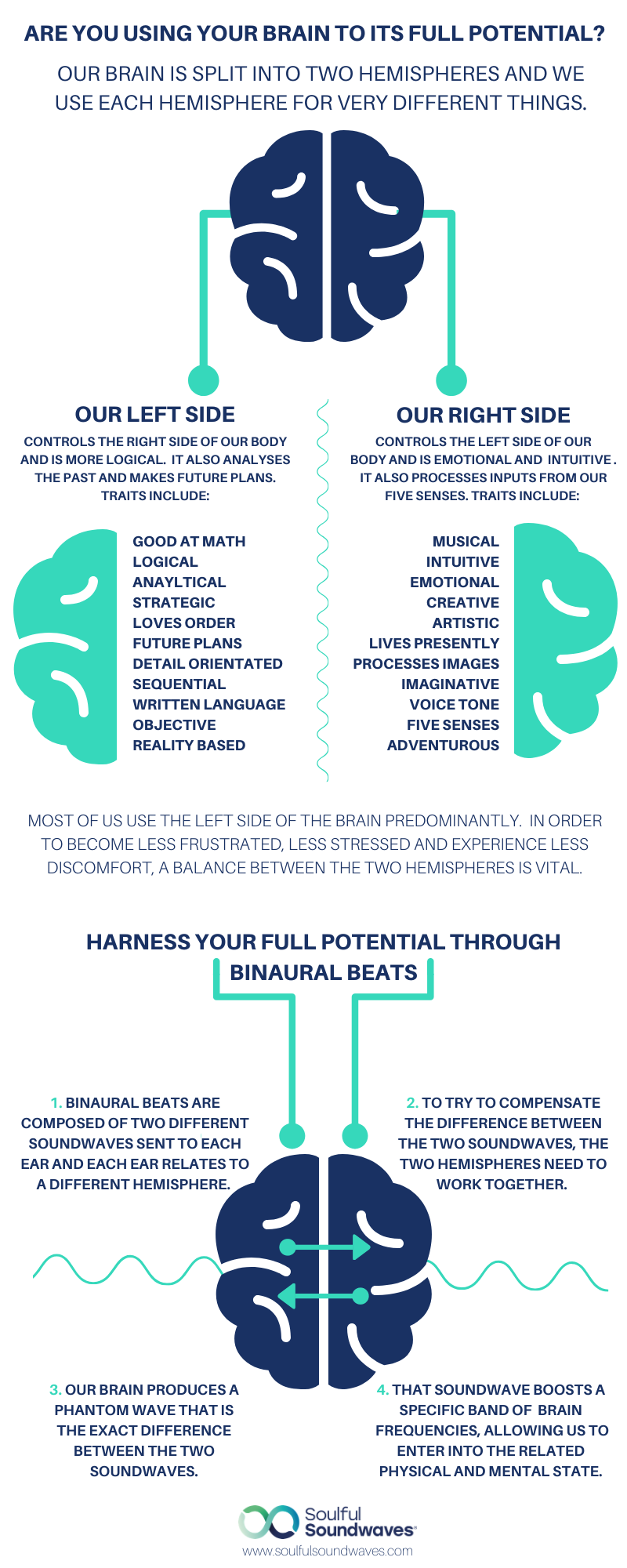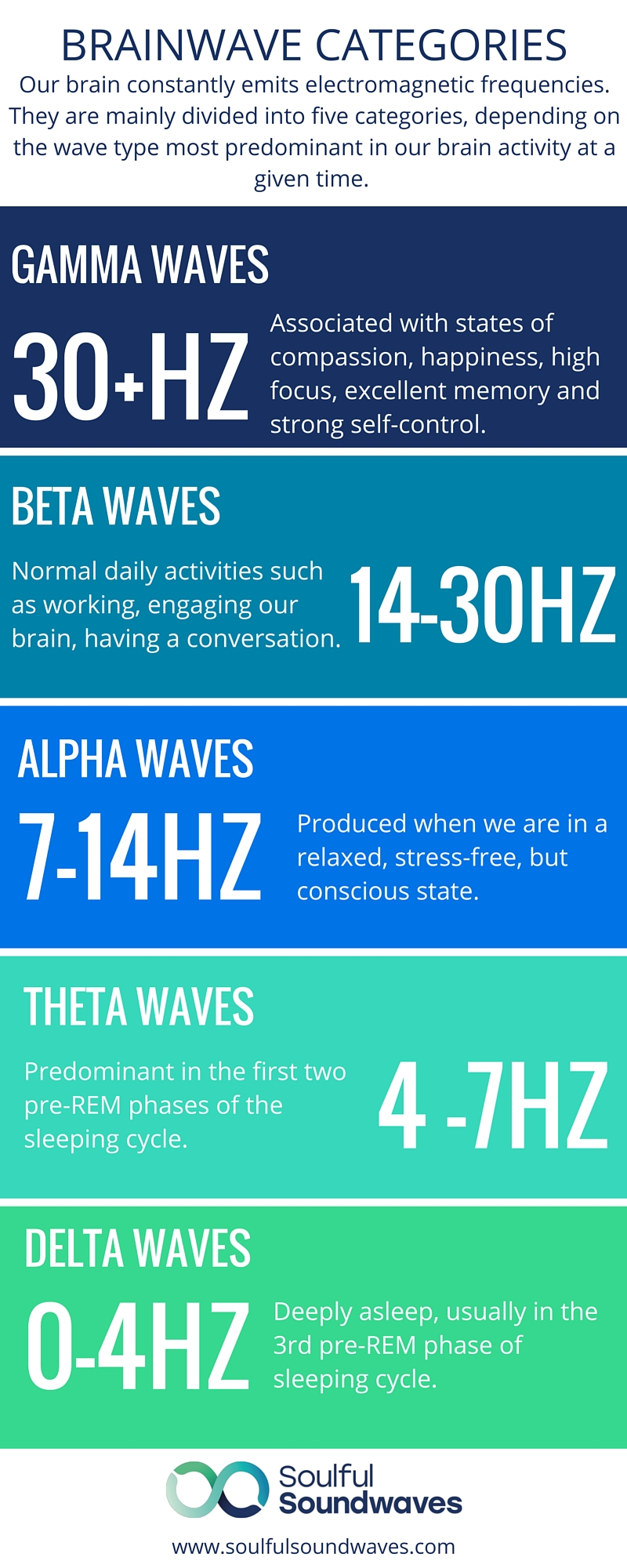Our music has been carefully composed, using binaural beats, monaural beats and isochronic tones, which are techniques used to describe three methods of brain entrainment (1). Through listening to these frequencies it is possible to entrain your brain and consequently set your body into a number of particular states in order to help you achieve a desired outcome.
WHAT ARE BINAURAL BEATS?
First discovered by Prussian physicist Heinrich Wilhelm Dove in 1839 (1), binaural beats are the effects created from listening to two different soundwaves delivered separately to the left and the right ear through earphones. A practical example would be playing a tone at a frequency of 100Hz to the right ear and another at 110Hz to the left ear. In the attempt to compensate this difference our brain creates a phantom wave whose frequency is the exact difference between the two sounds (in this example 10Hz).
By using binaural beats we can induce our brain into a desired state on demand, consequently sending a message to our body to align accordingly. Brainwaves are divided into five categories:
For example, imagine you are feeling rather stressed with the worries of life and it is time to go to sleep, but you are wide awake and your brain is working in over-drive. To help switch off, you can listen to a binaural beat track with theta or delta waves (or an entrainment between 0 and 7 Hz) to help slow down your mind and help induce you into sleep.
WHAT ARE MONAURAL BEATS?
Monaural beats are the most effective way to play healing frequencies through speakers. The main difference with binaural beats is the lack of stereo for the two soundwaves. In other words both speakers emit both right and left soundwaves at the same time. In some cases this might be the best alternative, for example if you are playing music to your children to get them to sleep. To make sure you can still enjoy our music, we have created all our tracks in monaural beats as well.
WHAT ARE ISOCHRONIC TONES?
At its simplest level, isochronic tones are single sounds that are being turned on and off rapidly. The effect is sharp, distinctive pulses of sound. They differ from binaural beats in that they use a single tone instead of two. The volume or intensity of the sound goes almost directly from 0 to 100 and back again in an evenly-spaced manner. This leaves a stronger impression on the brain, compared to binaural beats or other methods that use wave-like pulses (13).
WHY IS OUR MUSIC COMPOSED AT 432HZ?
Every mechanic wave (eg. a soundwave) travelling through a medium (matter) modifies the molecular structure of the medium itself by causing its molecules to bump into each other like falling dominoes transferring energy from one to the next. Through Cymatics, the study of sound made visible, we can visually represent how soundwaves affect mediums like sand and water. A great illustration of this is the video below by Nigel Stanford:
Considering that our body is composed mainly of water (~75%), this also means that a soundwave can directly affect our body and our organs - especially our brain.
We know music is made of soundwaves we are directly or indirectly exposed to every day. However, did you know that today’s western music is tuned at 440Hz? Practically, this means that the fourth A of the piano (A4) is precisely tuned at this frequency, and all the other notes are tuned accordingly. It has been so since 1955 when the International Organization for Standardization adopted it.
Music tuned at 440Hz is not well received by our body and it can create imbalance and anxiety. However, other tunings on the other hand provide a way better outcome.
432Hz tuning is well known as Pythagorean Tuning because of Greek philosopher and mathematician Pythagoras, who discovered a mathematic relationship between music notes five centuries B.C. This tuning is particularly beneficial, not only for our ears, but for our body as well (12) as it provides a match between the frequency of the notes and the frequency of natural sounds, such as the Schumann Resonance (9,10,11).
The Schumann Resonance, discovered by Winfried Otto Schumann between 1952 and 1954, is the sound produced by the magnetic field created between the ionosphere (positively polarised) and the earth (negatively polarised) at a frequency that ranges from 7.83Hz to 8Hz. It is a sound humans cannot hear, since our auditory range goes from 20Hz to 2KHz. But N.J.Cherry, associate professor of Environmental Health at the Lincoln University in New Zealand, showed that there is strong scientific evidence that the human brain detects and responds to the Schumann Resonance signal (9). Our brain reacts causing positive alterations in the melatonin/serotonin cycle balance that in turn produces cardiac, neurological and reproductive health effects in the human population.
8Hz is also the frequency of a note tuned at 432Hz, C-1. Following the Pythagorean matrix, every time we double that frequency we raise the note by an octave, reaching in this way the spectrum accessible from a human ear.
What does this mean in simple words? It means that our body and brain are strongly affected by soundwaves, including those coming from the music we listen to (most of which is tuned at 440Hz). This constant exposure has effects not only on our mood, but in the long run on our health too.
On November 6th 1988 Prof. Bruno Barosi, director of the Physical Acoustic Laboratory at the International Institute for Violinmaking in Cremona (Italy), carried out an experiment to establish the difference between 440Hz and 432Hz tunings (8). He discovered that sounds produced in the lower tuning (432Hz) have a greater abundance of harmonics, more colour and their volume and carrying capacity were greater. Many classical musicians and composers (Verdi and Mozart, amongst others) often tuned their orchestras at 432Hz. Tibetan monks tuned their singing bowls (one of the rare examples of monaural beats present in nature) by ear selecting healthy frequencies for mind and body. Yet many of them are precisely tuned at 432Hz.
The importance of using good frequencies that our physical body perceives as friendly is absolutely crucial to give our mind and body a chance to have a healthy break.
Our music composed over the binaural beats, as well as the binaural beats themselves, are specifically tuned at 432Hz. Every sound and every note’s frequency used in our tracks have been selected because of their natural beneficial properties.



